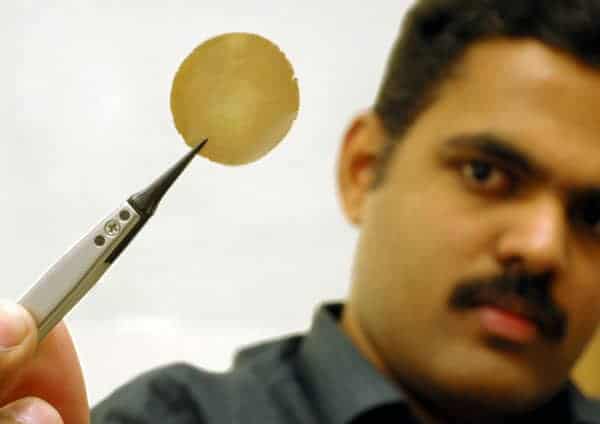
Two independent teams have made ultrathin, cabon-based membranes with extraordinary properties that could be used in a range of applications, from water filtration to petroleum processing. One team, based at the University of Manchester in the UK, has made membrane from graphene oxided that appears to be highly permeable to water while being impermeable to all other liquids and gases. The other group, at Japan’s National Institute for Materials Science, has made membranes from diamond-like carbon (DLC) that are highly permeable to certain organic solvents, but not others.
The Manchester team is led by Andre Geim, who co-discovered graphene in 2004. Graphene is a sheet of carbon just one atom thick in which the atoms are arranged in a lattice. Graphene oxide is like ordinary graphene but is covered with molecules, such as hydroxyl groups (OH). Graphene-oxide sheets stack atop each other to form extremely thin membranes.
Geim and colleagues found that water passes through a film of graphene oxide extremely fast while all other gases and liquids are completely blocked by the film. “We know that helium, for example, can leak through several millimetre-thick glass, which blocks water completely, so the behaviour we observed in graphene-oxide membranes could not be any stranger,” says team member Irina Grigorieva.
Like passing through air
The membranes consist of millions of small flakes of graphene oxide with nanometre-sized empty channels (or capillaries) between the flakes. According to the researchers, water is able to flow through the capillaries without any friction. Even more surprisingly, the water diffuses though the graphene-oxide sheets so quickly that the rate that it goes through is the same as if it were passing through empty air.
The graphene oxide sheets are arranged in such a way that there is room only for one layer of water molecules. When water passes through the capillaries it blocks the channels and so does not allow any other substance to go through, explains Grigorieva. In the absence of water, however, the capillaries shrink and do not let anything through this way. This is why the material is impermeable to everything but water.
This new property could be important for designers of filters and selective membranes, she said, and in situations where you need to remove water from a mixture or container while keeping in all the other ingredients. The work also shows that phenomena on the nanoscale are so different to those seen in the everyday, macroscopic world. “These phenomena defy our intuition but also open the door to a completely different world,” she tells physicsworld.com.
Brilliant ideas wanted
“Let experts in separation and filtration techniques now mull over these new results,” comments Geim. “Hopefully, they will come up with lots of brilliant application ideas.” As for the Manchester researchers, they say that they will continue looking for other unusual behaviour in graphene. “You cannot help wondering what else graphene has in store for us,” adds Geim.
Meanwhile, in Japan, Izumi Ichinose and colleagues National Institute for Materials Science in Ibaraki have created a carbon nanosheet that is extremely permeable to some organic solvents. Indeed, the membranes were used to separate organic dyes at rates 1000 times faster than commercially available membranes. The membranes are made of diamond-like carbon (DLC) – an amorphous material in which the bonds between carbon atoms are similar to those in diamond.
The team made its membranes by plasma-enhanced chemical vapour deposition (PECVD) of several different organic gases on an ultrathin substrate of cadmium nanostrands – which are then etched away to leave a free-standing film of DLC. The most successful membrane was made using acetylene but membranes were also made using pyridine and hexamethyldisiloxane.
The resulting free-standing DLC films are about 30 nm thick and about 12% of the surface of each film is perforated by tiny pores about 1 nm in diameter. The team measured the elasticity of the membranes, which they found to be in the range 90–170 GPa. This is on par with metals such as copper and titanium.
Hexane is the quickest
The researchers then looked at how permeable the films are to 10 different organic solvents. They found that hexane – a major component of petrol (gasoline) – was the quickest to move through the membrane. The alcohol butanol was the slowest to go through, moving at about 10% the speed of hexane.
According to Ichinose, the membranes are the first nanopore structures that are permeable to organic solvents – rather than water. As such, the team believes that the membranes could have a range of practical applications including cleaning up chemical spills, oil extraction in the food industry and the production of biofuels.
Indeed, Ichinose tells physicsworld.com that the team is currently working on the development of “large-scale porous carbon nanosheets”. In principle, the team’s technique could be used to make membranes on an industrial scale. But before this can be done, the team must find a low-cost alternative to the cadmium substrate. According to Ichinose, viable alternatives include durable carbon-fibre sheets or cross-linked polyimide sheets.
Cees Dekker of the Delft University of Technology in the Netherlands says that when taken together, the studies reveal an “unexpected phenomenon” – that ultrathin carbon membranes can have permeability values that are very selective for certain molecules.
The work of both teams is reported in two separate papers in Science.



